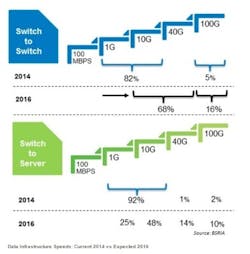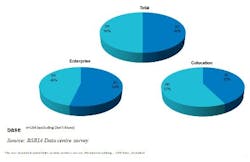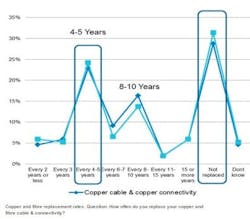BSRIA has released data from a recent survey it conducted focused on data center cabling. Among the high-level conclusions that can be drawn from the survey are that the top-of-rack (ToR) architecture is more popular in colocation facilities than it is in enterprise data centers, the shift from 1G and 10G to 40G and 100G for switch-to-switch connections is on, and a significant number of data center operators consider their cabling to be permanent—with no history of replacing it nor any plans to do so.
As a predicate to the survey results, BSRIA explained that approximately 19 percent of the global market for structured cabling is installed in data centers, while the remaining 81 percent is installed in LAN applications. Based on its yearly research, BSRIA has determined the structured cabling installed in data centers is estimated at $1.2 billion in 2014. “The data centre segment is expected to continue its increase with huge demand for backup data, video storage, peer-to-peer file sharing, cloud computing and the uptake of the Internet of Things with numerous devices being connected in the future,” BSRIA commented.
This latest research covers five countries—U.S., U.K., Germany, China, and Brazil—which combine to account for approximately 68 percent of worldwide data center cabling, according to BSRIA.
Herein are data points and associated charts, provided by BSRIA, based on this most recent research.
“The study highlighted quite significant levels of 1G and 10G both in switch-to-switch and switch-to-server links and expected progression to 40G and 100G planned for 2016,” BSRIA noted. Indeed, in switch-to-server connections, 1G and 10G combined to account for 92 percent of connections—a figure that BSRIA expects to drop to 73 percent by next year. And while 40G and 100G combined to account for 3 percent of connections last year, those speeds will combine to account for 26 percent in 2016.



